The great Dutch engraver Maurits Cornelis Escher (Leeuwarden, 1898 - Laren, 1972) loved Italy very much: he visited our country for the first time at the age of twenty-four, in 1922. The artist arrived in Italy by sea, in Genoa, and from there he continued his journey visiting Tuscany, making stops in Livorno, Pisa, Florence, Siena and San Gimignano. It was especially the villages and countryside of Siena that struck Escher, so much so that it was here that he made his first etchings depicting Italian landscapes. The journey then continued in 1923, when the artist spent the entire spring on the Amalfi Coast: “Rarely,” he wrote to his friend Jan van der Does as early as January 18 of that year, “have I felt calmer, more satisfied, more contented than I have been in recent times.” In Ravaello, Escher also met his future wife, the Swiss Giulia Umiker (nicknamed Jetta): the two were married, after some difficulties, in Viareggio town hall on June 12, 1924, and four days later, in Rome, they celebrated the marriage in religious form (Jetta had in fact recently become a Catholic despite the opposition of her father, who frowned upon it), and then left for the honeymoon that took them to Genoa, Annecy, Paris and Brussels. Upon their return, the couple settled in Rome.
Escher took a house in a villa at 122 Via Poerio, in the Monteverde vecchio district, and lived in the capital for twelve years, until 1935, when the family felt that the rise of Fascism had become untenable and made it difficult to continue living in Italy (the couple did not want their young children to grow up under a dictatorship, and therefore decided to move to Switzerland). The stay in Rome produced a profound influence on his art, since, during this period, the subjects of his etchings were mainly landscapes and architecture. The first exhibition was held between May 2 and 26, at Palazzo Venezia, and was also quite successful: Escher was well-connected in the Roman cultural circles of the time (for example, he was friends with the director of the Dutch Institute in Rome, Goedefridus Johannes Hoogewerff, who was a great admirer of his as well as a patron of several works, and was a regular attendee of Adolfo Venturi ’s lectures at the University of Rome) and his knowledge pushed him to delve deeper into the history and art of the city, but what attracted him most were the views and vistas that the city could offer and which Escher loved to explore at night, carrying a lamp with him so that he could draw wherever he was. In fact, the artist, in Rome, used to do his drawing directly on the spot, and then finish it in his studio, which he made in one of the rooms of the villa on Via Poerio. What especially fascinated him were the views of ancient and Baroque Rome: the great churches, with their majestic domes, and the ruins of classical Rome are frequent subjects in the engravings produced during the twelve years he lived in Rome.
By Escher’s own admission, the years in Rome were the best of his life, and production during this period was very prolific. Several of the engravings the artist made in the capital are displayed in almost every exhibition dedicated to him: in the most recent, the Escher exhibition in Trieste (until June 7, 2020 in the Salone degli Incanti), seven of them are on display, plus one, very famous, that does not depict Rome directly but was produced in the city. Let’s see them all in this gallery.
1. San Michele dei Frisoni
The church of St. Michael of the Frisians is located in the Borgo district, not far from St. Peter’s Basilica, and is the national church of the Roman community of Frisians (i.e., the inhabitants of Friesland, a region in the north of the Netherlands of which Leeuwarden is the capital: it is therefore the reference church of the community to which Escher belonged). The bold perspective chosen by Escher makes the church stand out against the Bernini colonnade of St. Peter’s, with an effective contrast between light and shadow.
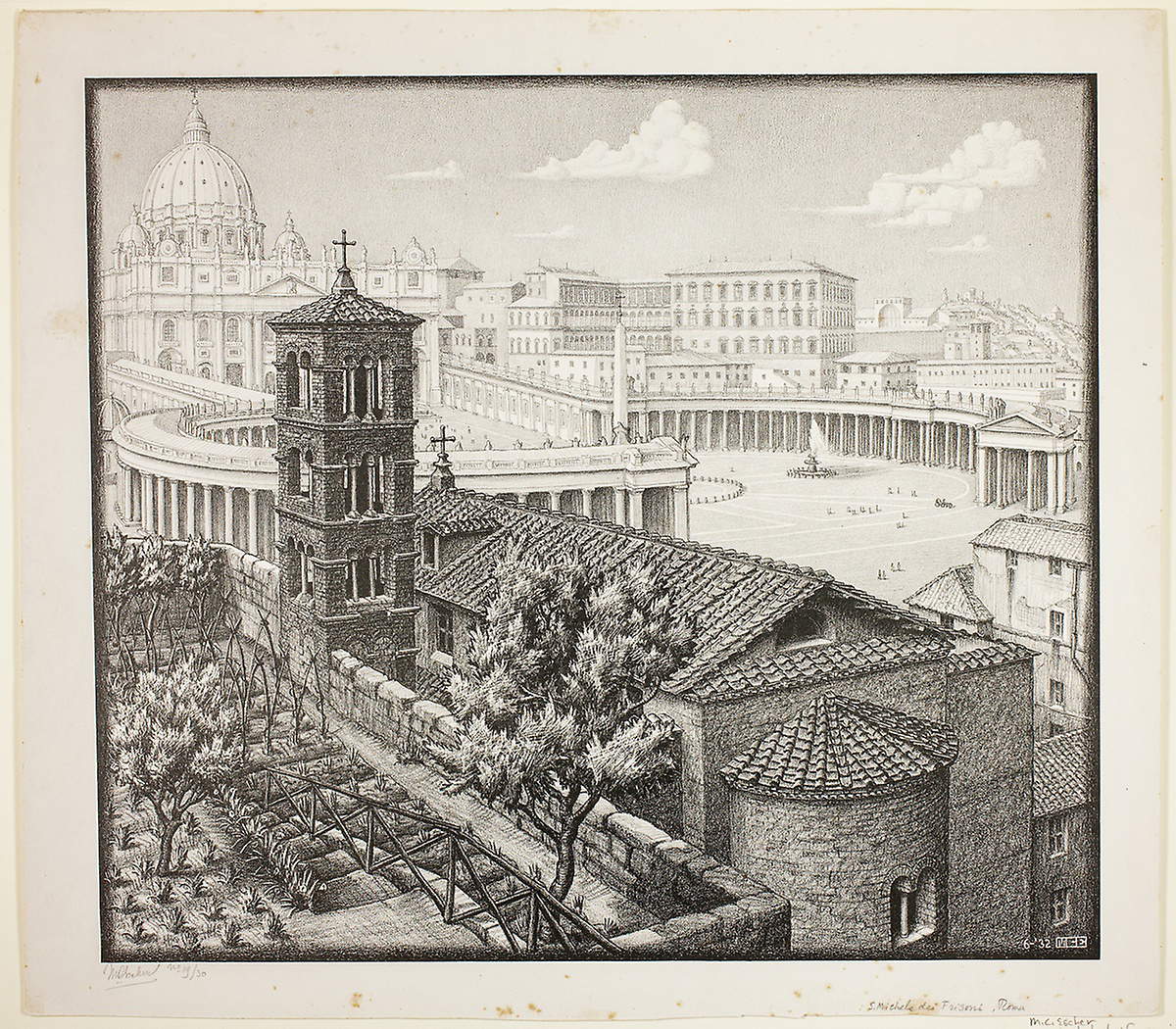 |
| Maurits Cornelis Escher, San Michele dei Frisoni, Rome (1932; lithograph on paper, 492 x 558 mm; Chicago, Art Institute). A specimen from a private collection is on display at the Trieste exhibition. |
2. Between St. Peter’s and the Sistine Chapel.
In the Rome exhibition catalog we read that “Escher is attracted by the contrast between the pure volumes of the exterior of the Sistine Chapel, red brick rising in oblique buttresses, and the white marble of the Basilica carved in Michelangelo’s proto-baroque forms. The sunlight of Rome does the rest, and the charm of art is fully restored.”
 |
| Maurits Cornelis Escher, Between St. Peter’s and the Sistine Chapel (1936; lithograph on paper, 311 x 220 mm; The Escher Foundation) |
3. Interior of St. Peter’s
Made from a drawing that Escher executed directly in St. Peter’s Cathedral, this is one of Escher’s most complex wood engravings, given the great richness of detail and the meticulousness with which the artist brought back the elements of the floor and architectural elements, taking great care to calibrate the shadows. About this engraving, Escher wrote: “On that occasion I noticed that all the vertical lines were directed toward a single point: the nadir. This print was perhaps the initial cause of the series of perspective fantasies that I executed in the many years that followed.”
 |
| Maurits Cornelis Escher, Interior of St. Peter ’s (1935; head woodcut, 237 x 316 mm; Private collection) |
4. Colonnade of St. Peter’s
This woodcut depicting Gian Lorenzo Bernini ’s Colonnade at night is one of the etchings that are part of the series devoted to nocturnal Rome, which allowed Escher to try his hand at shadow depiction techniques. The artist worked almost exclusively at night to execute the drawings on site, using the dim light of a candle to make himself light. The next morning the artist would complete the work by finishing the sketch and translating it into engraving. In this depiction of the colonnade of St. Peter’s, we read in the Trieste exhibition catalog, “the exclusive use of diagonal cuts produces not only lombre, but also the illusion of illumination from a directional source.”
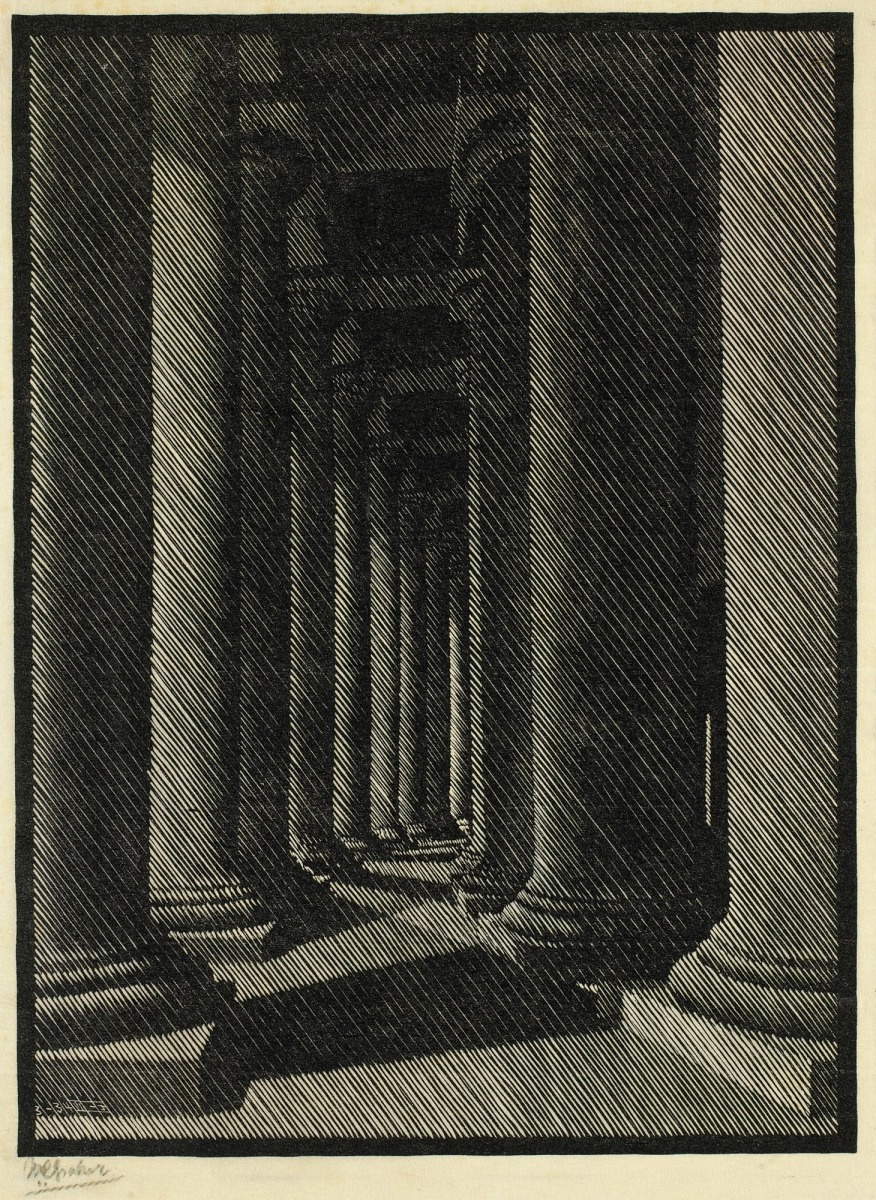 |
| Maurits Cornelis Escher, Interior of St. Peter ’s (1935; woodcut, 331 x 229 mm; Private collection) |
5. Trajan’s Column
Trajan’s Column is the protagonist of another nocturnal view: the monument stands out against the shadowed profile of the Church of the Most Holy Name of Mary in the Forum Trajan, and the expedient of using diagonal lines arranged in a radial pattern (right around the dome of the church, which serves as the centerpiece of the composition) serves to give the impression that the illumination comes from a single source of light.
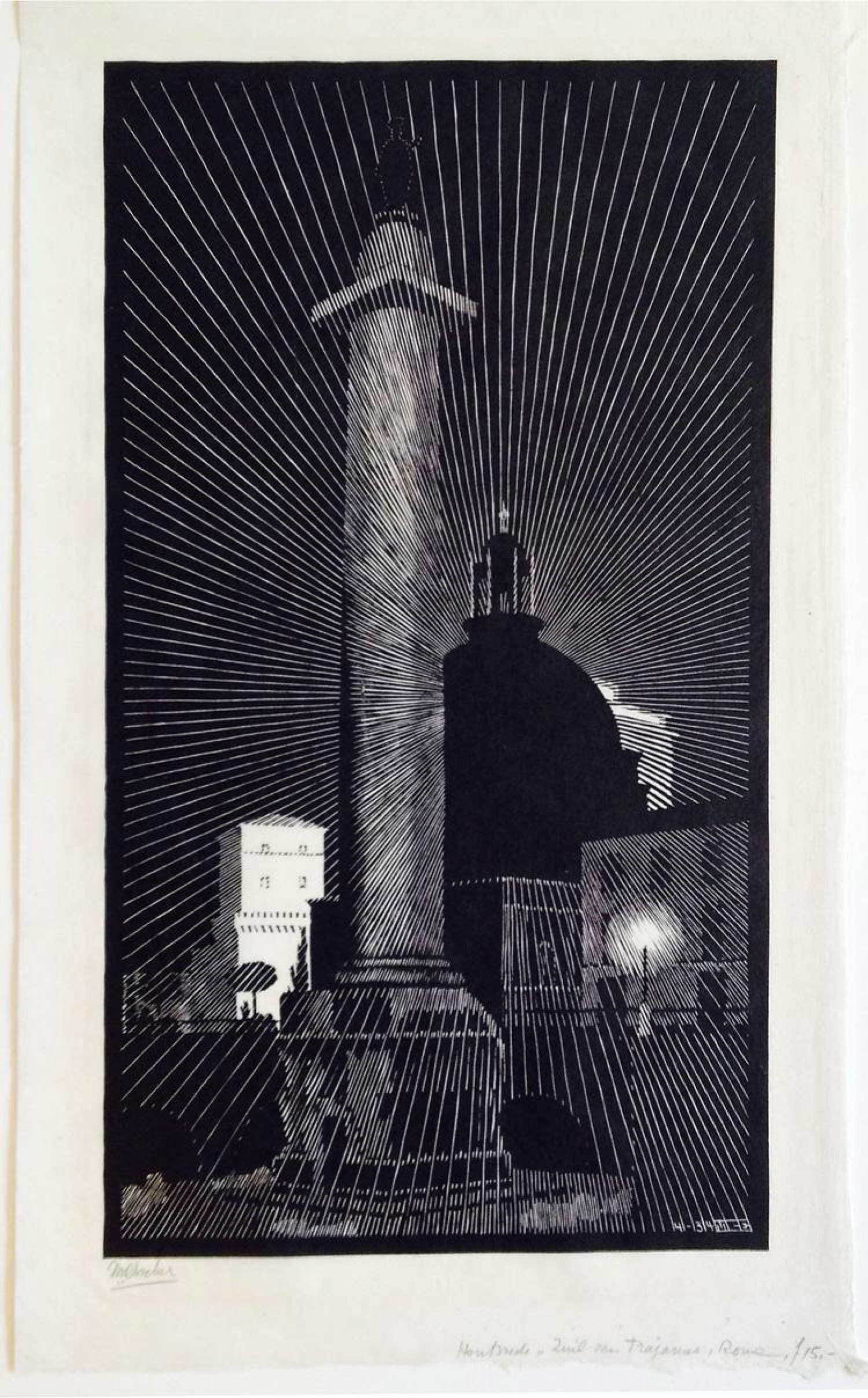 |
| Maurits Cornelis Escher, Trajan’s Column (1934; woodcut, 334 x 185 mm; Private Collection) |
6. Rome by night: the Basilica of Constantine
Another view from the series of glimpses of Rome at night. Here the novelty, we learn from the catalog of the Trieste exhibition, “lay in the fact that the artist took into account the artificial lighting of the monuments, which took on a very striking appearance.”
 |
| Maurits Cornelis Escher, Rome by Night: the Basilica of Constantine (1934; woodcut, 210 x 310 mm; Private collection) |
7. Rome by night: the Colosseum
The views of Rome by night could not fail to include the Colosseum, which Escher has a way of depicting from the inside, rendering, with the usual play of light and shadow, the impression of the shapes of the arches and columns, and employing yet another technique to render the shading: this time with small strokes arranged almost according to geometric shapes.
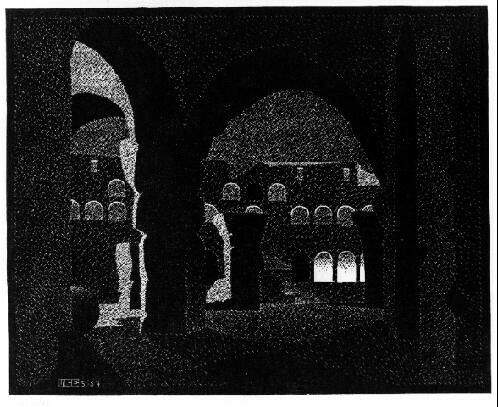 |
| Maurits Cornelis Escher, Rome by Night: Colosseum (1934; woodcut, 230 x 294 mm; Private collection) |
8. Hand with reflecting sphere
Perhaps not everyone knows that what is perhaps Escher’s most famous work, Hand with Reflecting Sphere, was made in Rome: what we see reflected in the sphere held by the hand is in fact the painter’s self-portrait in his Roman studio set up in the villa on Via Poerio. About this work, Escher had a self-deprecating comment to make: “the artist’s ego is invariably at the center of the world.”
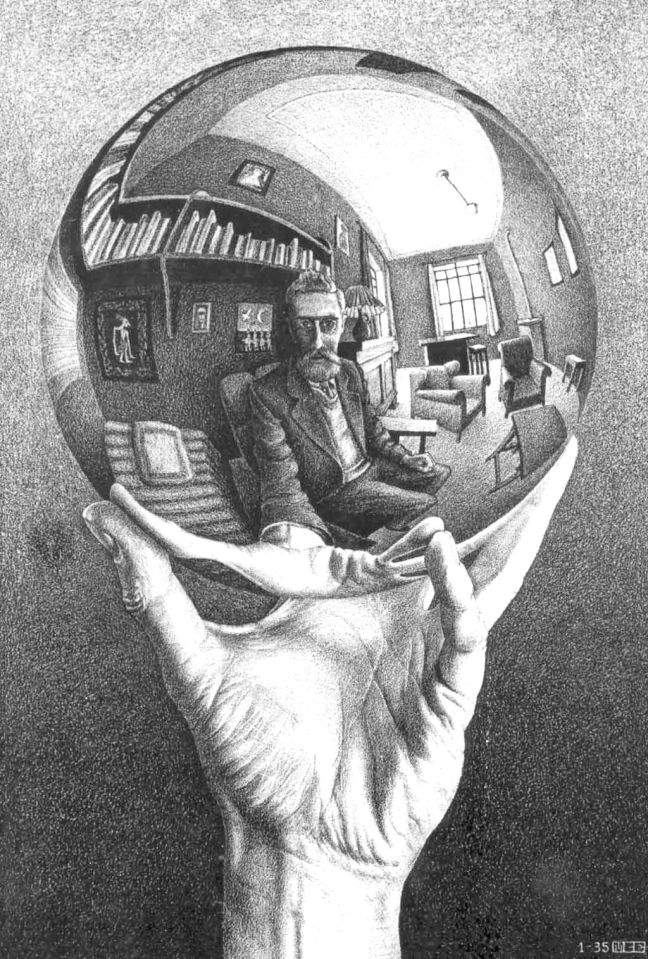 |
| Maurits Cornelis Escher, Hand with Reflecting Sphere (1935; lithograph on paper, 318 x 213 mm; Private Collection) |
Warning: the translation into English of the original Italian article was created using automatic tools. We undertake to review all articles, but we do not guarantee the total absence of inaccuracies in the translation due to the program. You can find the original by clicking on the ITA button. If you find any mistake,please contact us.